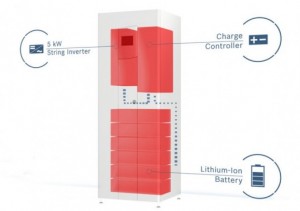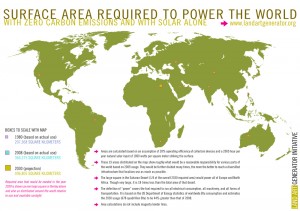Cool news…using batteries from the gigafactory Tesla is building outside of Reno, Solar City will be including battery backup systems in 100% of the rooftop solar systems they install within 5-10 years. This is significant partly because it helps illustrate the rapidly decreasing costs of both solar panels and battery backup systems, but also because it is likely to have a major impact on our current energy production and distribution systems…the old grid will become obsolete eventually, but the transition won’t be easy for the larger energy companies. Read more at climaterocks.com.
Plug and play solar energy storage system for the home
 Bosch is selling a near plug and play energy storage system for home use, the BPT-S 5 Hybrid, a refrigerator-sized cabinet that houses a large battery, charge controller and inverter, to simplify integration with a house’s existing solar and grid lines. Installation is estimated at a mere two hours! It’ll charge up when your solar panels are producing excess energy, and discharge that into your house as needed at night. Unfortunately…it’s only available in Germany at this point. 🙁
Bosch is selling a near plug and play energy storage system for home use, the BPT-S 5 Hybrid, a refrigerator-sized cabinet that houses a large battery, charge controller and inverter, to simplify integration with a house’s existing solar and grid lines. Installation is estimated at a mere two hours! It’ll charge up when your solar panels are producing excess energy, and discharge that into your house as needed at night. Unfortunately…it’s only available in Germany at this point. 🙁
Powering the World with Solar
 Solar panels take space, but just how much land area would need to be covered with solar panels to provide 100% of this planet’s power needs (including transportation)? The answer is pretty surprising, as the image here shows (click on it for a larger version). It helps show just how much energy the sun is sending our way, and what a small percentage of that is actually required to power our civilization.
Solar panels take space, but just how much land area would need to be covered with solar panels to provide 100% of this planet’s power needs (including transportation)? The answer is pretty surprising, as the image here shows (click on it for a larger version). It helps show just how much energy the sun is sending our way, and what a small percentage of that is actually required to power our civilization.
There’s still a matter of energy storage with solar panels, but I wonder, if long range transmission efficiency could be boosted to the point where we have a global power grid? The sun is always shining on about half the planet…if that power could be transmitted to the dark side of the planet, there would be no need to store electricity. Nikola Tesla suggested that just such a system could be possible. The drawbacks are obvious though…it would be difficult or even impossible to employ Tesla’s system in a way that would allow companies to control who uses that energy. The business model falls apart, sadly, and we live in a world controlled by business and profit.
Energy payback of solar (PV) panels
Does the production of solar panels require more energy than the panels will produce in their lifetime? That’s a question you may hear now and again, especially when talking to those who aren’t really on board with this whole clean energy idea. So, time to set the record straight. There’s a great article over at Care2.com that addresses just this subject. The bottom line is that depending on what technology of panel you’re talking about, the energy payback point (they’ve produced as much energy as it took to manufacture the panel) is from one to four years. Check out the full link above if you want all the details.
Grid-scale 10MWh battery
To address concerns over solar and wind power fluctuations, the UK is installing a 10MWh battery…it’s not huge in terms of typical grid power usage, but is another big milestone in weaning us off of fossil fuels. Read more over at gizmag.

